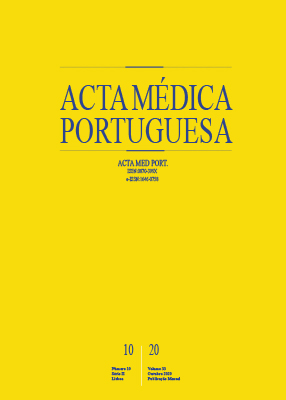Falls in unilateral lower limb amputees living in the community. A Portuguese study.
DOI:
https://doi.org/10.20344/amp.12615Keywords:
Accidental Falls, Amputation/rehabilitation, Amputees/rehabilitation, Lower ExtremityAbstract
Introduction: Lower limb amputees present a high risk of falling. This study aims to characterise fall history in unilateral lower limb amputees that are autonomous in the community, identifying differences between transfemoral and transtibial amputees and assessing fear of falling between fallers and non-fallers.
Material and Methods: Descriptive, cross-sectional study of consecutive community-dwelling unilateral lower limb adult amputees of any aetiology, attending outpatient consultation in a Portuguese Physical and Rehabilitation Medicine central and university hospital department. Inclusion criteria: a prior 12 week individualised rehabilitation program for prosthesis training; regular prosthesis use for more than one year with autonomous gait; and a Functional Independence Measure® score equal to or greater than 100. Injury severity was classified according to the National Database of Nursing Quality Indicators® injury falls measure. In order to assess walking performance over short distances and fear of falling we used the 10-meter walk test and the Falls Efficacy Scale, respectively.
Results: In a sample of 52 lower limb amputees, mainly men (80.8%) and of traumatic aetiology (63.5%), with a mean age of 57.21 ± 11.55 years, 36.5% reported at least one fall in the previous 12 months, all classified as minor injuries. Transfemoral amputees (n = 23) presented a higher number of falls (2.22 ± 3.23, p = 0.025) and lower gait velocity (0.77 ± 0.26 m per second, p < 0.001). Regarding fear of falling, we found no significant differences between fallers and non-fallers.
Discussion: The prevalence of falls was low and of minor severity. Transfemoral amputees fell more often and were slower. There were no reported differences in fear of falling between groups.
Conclusion: This paper contributes information about Portuguese lower limb amputees, whose studies are scarce and are rarely dedicated to falling.
Downloads
Downloads
Published
How to Cite
Issue
Section
License
All the articles published in the AMP are open access and comply with the requirements of funding agencies or academic institutions. The AMP is governed by the terms of the Creative Commons ‘Attribution – Non-Commercial Use - (CC-BY-NC)’ license, regarding the use by third parties.
It is the author’s responsibility to obtain approval for the reproduction of figures, tables, etc. from other publications.
Upon acceptance of an article for publication, the authors will be asked to complete the ICMJE “Copyright Liability and Copyright Sharing Statement “(http://www.actamedicaportuguesa.com/info/AMP-NormasPublicacao.pdf) and the “Declaration of Potential Conflicts of Interest” (http:// www.icmje.org/conflicts-of-interest). An e-mail will be sent to the corresponding author to acknowledge receipt of the manuscript.
After publication, the authors are authorised to make their articles available in repositories of their institutions of origin, as long as they always mention where they were published and according to the Creative Commons license.









